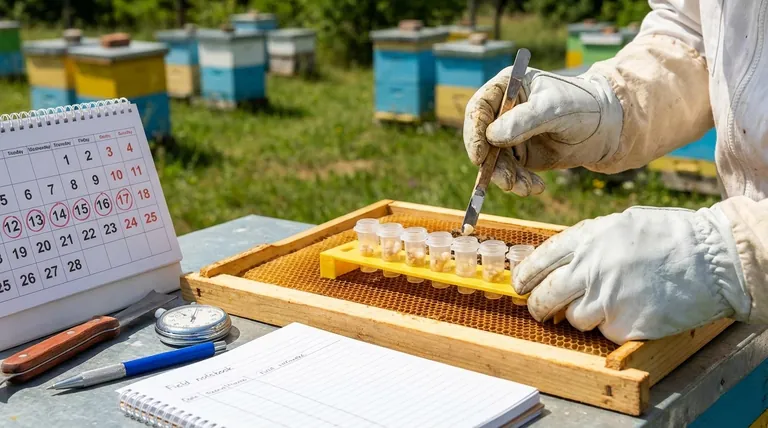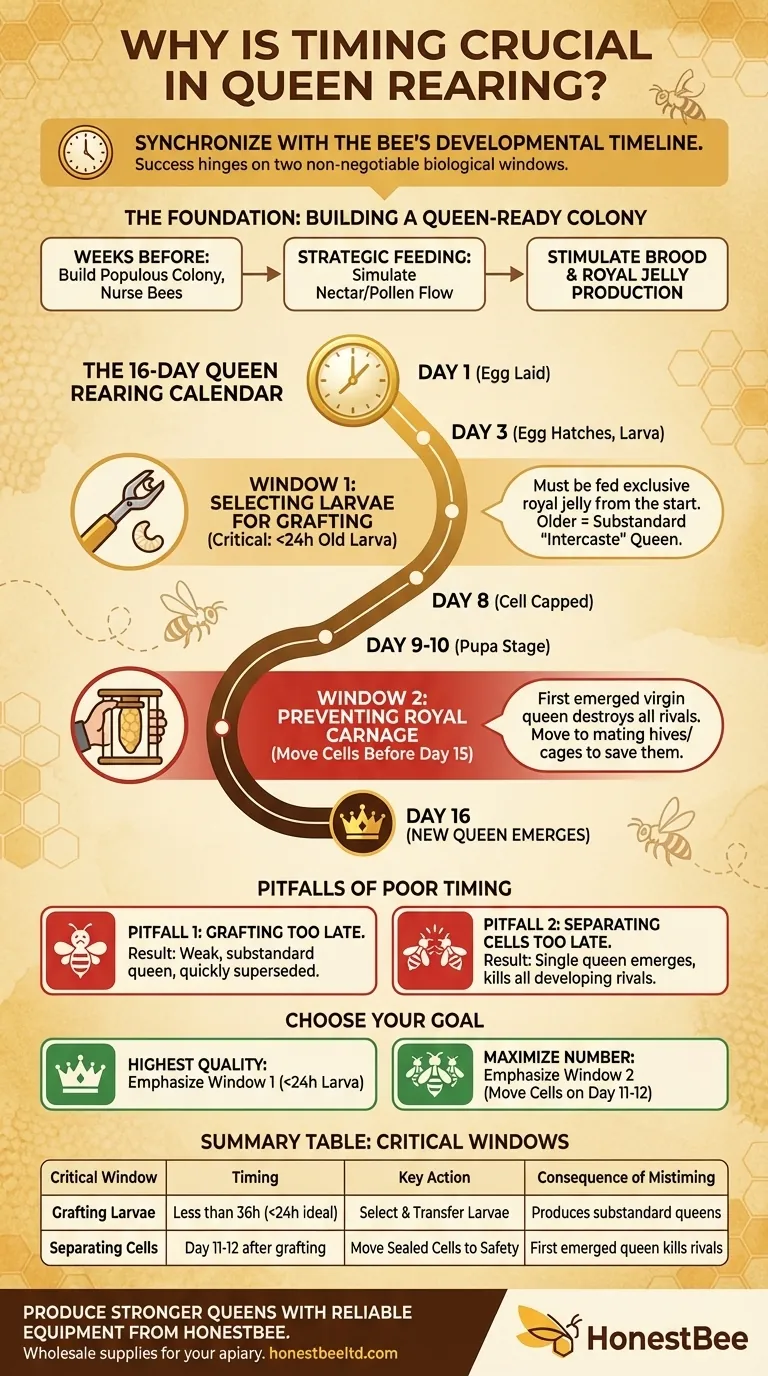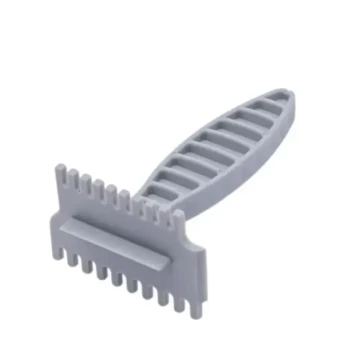In queen rearing, timing is not just important—it is everything. Success is dictated by two non-negotiable biological windows: the brief period when a larva is young enough to become a queen and the moments before the first new queen emerges to destroy her rivals. Aligning your actions with this natural, unchangeable schedule is the absolute key to producing new queens.
Queen rearing is the art of synchronizing your beekeeping practices with the honey bee's fixed developmental timeline. Your success hinges on intervening at two critical points: selecting larvae at the very start of their life and isolating queen cells at the very end of their development.

The Foundation: Building a Queen-Ready Colony
Before you even think about grafting, you must prepare the colony. The timing of this preparation phase sets the stage for the entire process.
Why Pre-Season Timing Matters
A colony cannot produce high-quality queens if it is not biologically primed to do so. Queen rearing requires an abundance of resources and a specific demographic of bees.
This means starting your preparations weeks in advance, ensuring the colony is populous, healthy, and has a strong force of young nurse bees ready to produce the vast amounts of royal jelly required.
The Role of Strategic Feeding
Supplemental feeding is used to simulate a natural nectar and pollen flow, which stimulates brood rearing. However, feeding at the wrong time is counterproductive.
Feeding pollen substitute in late autumn or winter, for example, can create a population of nurse bees that consume vital stores with no brood to care for. The right time to feed is a few weeks before you plan to graft, when you want to actively encourage the queen to lay and build up the nurse bee population.
The Critical Windows of Queen Development
Once your colony is prepared, the queen rearing process itself is governed by a strict, 16-day schedule. Missing a key window by even a day can result in complete failure.
Window 1: Selecting Larvae for Grafting
The most crucial decision is selecting the right larvae to graft—the process of transferring them into artificial queen cups. A larva destined to become a queen must be fed an exclusive diet of royal jelly from the moment it hatches.
For this reason, you must select larvae that are less than 36 hours old, and ideally less than 24. A larva older than this will have already received some "worker food," and while it may develop into a queen, she will be substandard. This window is absolute.
The Queen Rearing Calendar
Once grafted, the clock starts. The total development time from egg to emerged queen is 16 days. Since you are grafting a 1-day-old larva (which was a 3-day-old egg), you have approximately 12 more days until emergence.
Your grafted larvae will be fed, and the workers will draw out and seal the queen cells around day 5 after grafting. This is your next major timing cue.
Window 2: Preventing Royal Carnage
The first virgin queen to emerge has a single instinct: kill all rivals. She will immediately seek out other sealed queen cells, chew a hole in the side, and sting the developing queens inside to death.
To prevent this, you must move the sealed queen cells to separate mating hives or protect them in cages before the first queen emerges. This typically happens on day 15 or 16 from the day the egg was laid. If you are a day late, you may find all your work has resulted in just one queen instead of dozens.
Understanding the Pitfalls of Poor Timing
Mistakes in timing are not minor setbacks; they are fundamental failures that undermine the entire operation.
The Cost of Grafting Too Late
If you graft larvae that are too old, you are not creating a queen. You are creating a "worker-queen intercaste"—an animal that is not fully developed for either role. These queens are often small, have poor laying patterns, and will be quickly superseded by the colony, wasting your time and resources.
The Consequence of Separating Cells Too Late
Waiting too long to move your mature queen cells is the most dramatic and costly timing error. All the effort of preparing the colony, grafting larvae, and managing the cell builder can be undone in a few hours by a single, newly emerged virgin queen.
The Danger of Premature Preparation
As noted, building up a colony out of season is wasteful and stressful. It burns through the colony's winter stores and can create population imbalances that leave it vulnerable. The goal is to have the colony reach peak strength precisely when natural resources can support it and queen rearing is viable.
Making the Right Choice for Your Goal
Your specific timeline should be managed according to your primary objective.
- If your primary focus is producing the highest quality queens: Emphasize the first window by selecting only the tiniest, C-shaped larvae that are barely visible (under 24 hours old).
- If your primary focus is maximizing the number of viable queens: Emphasize the second window by having your mating nucleus boxes ready and being prepared to move all cells on day 11 or 12 after grafting, without fail.
Ultimately, successful queen rearing is achieved by respecting and mastering the colony's natural rhythms.
Summary Table:
| Critical Window | Timing | Key Action | Consequence of Mistiming |
|---|---|---|---|
| Grafting Larvae | Less than 36 hours old (ideally <24h) | Select and transfer larvae | Produces substandard "intercaste" queens |
| Separating Cells | Day 11-12 after grafting | Move sealed queen cells to safety | First emerged queen kills all rivals |
Produce Stronger Queens with Reliable Equipment from HONESTBEE
Mastering the precise timing of queen rearing requires dependable tools. Whether you are a commercial apiary scaling up production or a distributor supplying beekeepers, HONESTBEE provides the high-quality, wholesale-priced equipment you need to succeed.
We supply essential queen rearing supplies, including grafting tools, cell bars, and mating nucs, designed for efficiency and durability to keep your operations perfectly on schedule.
Let's discuss your specific needs. Contact our wholesale team today to get the right equipment for your queen rearing program.
Visual Guide

Related Products
- No Grafting Queen Rearing Kit: System for Royal Jelly Production and Queen Rearing
- Nicot Queen Rearing Kit for Beekeeping and Grafting in Nicot System
- Brown Nicot Queen Cell Cups for Breeding Queen Bees Beekeeping
- Plastic Chinese Queen Grafting Tool for Bee Queen Rearing
- JZBZ Push-In Queen Cell Cups for Beekeeping
People Also Ask
- What is the timeline for queen breeding? A 28-Day Guide from Egg to Laying Queen
- What should be done once eggs are present in the comb box? A Guide to Maximizing Queen Rearing Success
- What are the stages involved in queen raising? A Guide to Controlled, High-Quality Queen Production
- What do queen rearers do with queens that fail to lay on time? The Critical Quality Control Decision
- What steps should be taken if a queen is lost? Save Your Queenless Hive Now



















